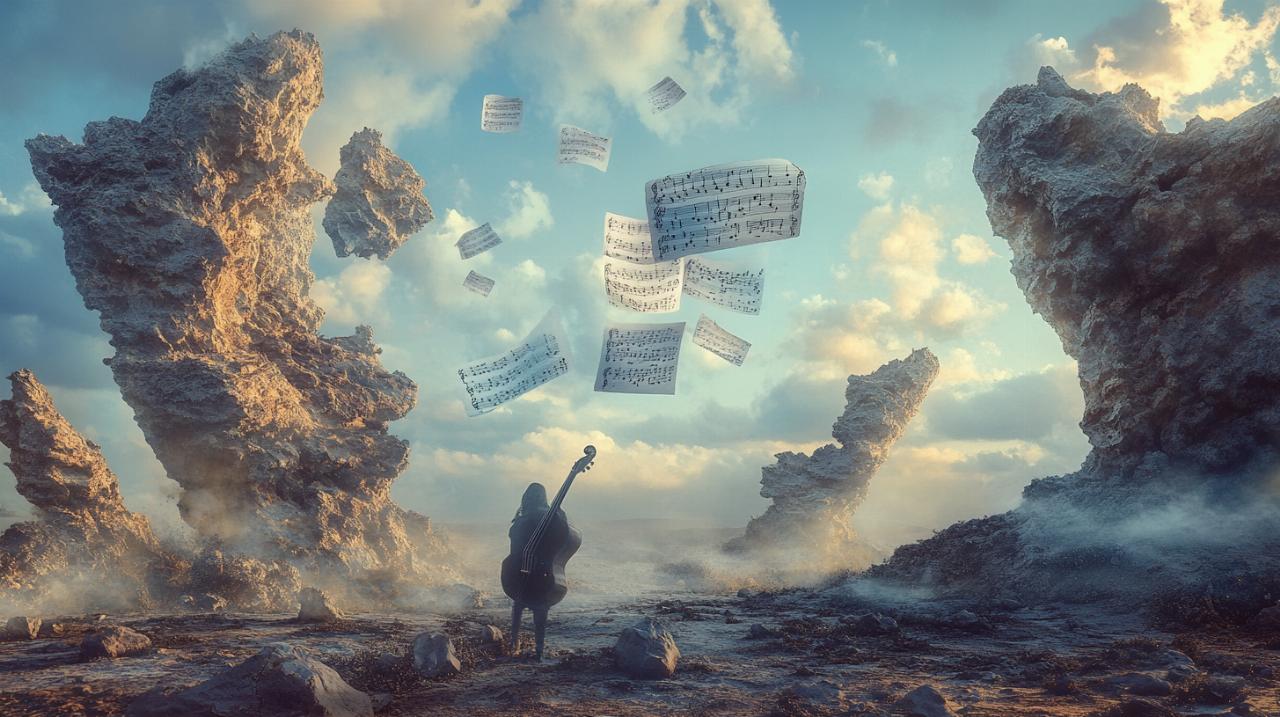Photography has long been a medium where technical skill meets artistic vision, yet some of the most compelling work emerges when creators draw from unexpected wellsprings of inspiration. The fusion of philosophical inquiry with the raw energy of rock music creates a distinctive visual language that challenges conventional aesthetics whilst celebrating both intellectual depth and visceral emotion. This exploration reveals how contemporary photographers are crafting images that resonate with existential questions and rebellious spirit, forming a bridge between thought and sound, between contemplation and performance.
Existential visual narratives: merging philosophical depth with rock rebellion
The intersection of philosophical thought and rock music in photography opens pathways to capturing the human condition in ways that traditional approaches often miss. Elliott Landy, who served as the official photographer at Woodstock and documented the 1960s counterculture, understood intuitively that photography could capture inner feelings and influence viewers beyond mere documentation. His work with musicians like Bob Dylan, Janis Joplin, and Jimi Hendrix alongside his coverage of anti-Vietnam War protests demonstrated how the camera could become a tool for expressing the era’s philosophical questioning of authority and conventional values. Landy relied on intuition rather than conscious effort to translate the energy of performers, allowing the photographs to speak to something deeper than technical perfection. This approach aligns with what Keith Beven, Emeritus Professor of Hydrology at Lancaster University, describes when discussing realism in photography: the acknowledgement that images are interpretations rather than pure representations of reality. The concept of noble lies in photography suggests that what we capture is always filtered through our perspective, much like how rock music distils complex emotions into sonic expressions that bypass rational thought to reach something more primal.
Capturing the Absurd Through Concert Photography and Street Portraiture
Concert photography naturally lends itself to exploring absurdist philosophy, where the staged chaos of live performance mirrors the fundamental disconnection between human desire for meaning and the universe’s indifference. The photographer working in this space must embrace spontaneity and uncertainty, qualities that align with existential thought. Sean Tucker, who specialises in portraits, street photography, and rural photography, creates philosophical films exploring the why behind creative drive, including examinations of creative jealousy, the artist’s ego, and making authentic creative work. His approach to Miss Lavanda photography demonstrates how capturing authentic moments requires photographers to confront their own motivations and relationship with their subjects. In street portraiture, this philosophy becomes even more pronounced as photographers encounter strangers whose brief presence offers glimpses into lives that exist completely independent of the camera’s gaze. The challenge becomes capturing not just what is seen but the feeling of existence itself, the weight of being in a particular moment. Landy’s friendly and casual connection with Janis Joplin, rather than a deeply personal relationship, allowed him to photograph her with respect whilst maintaining the distance necessary for honest observation. This balance between engagement and detachment reflects the phenomenological approach of experiencing phenomena as they present themselves rather than imposing predetermined narratives upon them.
Visual Metaphors of Freedom: Translating Nietzschean Concepts into Rock-Inspired Imagery
Friedrich Nietzsche’s philosophy of individual will, the rejection of conventional morality, and the embrace of life’s challenges finds natural visual expression in rock-inspired photography. The Übermensch concept, the idea of creating one’s own values rather than accepting inherited systems, parallels both the rock musician’s rebellion against musical convention and the photographer’s rejection of established aesthetic rules. Keith Beven’s book Panta Rhei, supporting WaterAid, takes its title from the ancient Greek phrase meaning everything flows, a concept central to understanding change and impermanence. This philosophical foundation supports a photographic practice that embraces the transient nature of experience rather than attempting to freeze moments in artificial permanence. The contrast between realistic and artistic landscape photography, with examples like photomontage and extreme post-processing, illustrates how photographers must choose their relationship with truth and manipulation. David Hockney’s work demonstrates breaking the barriers of the still image, creating composite pieces that acknowledge the constructed nature of all visual representation. In rock-inspired photography, this might manifest as deliberately over-saturated colours that capture the heightened emotional state of a live performance rather than the literal lighting conditions. The Natural Landscape Photography Awards define realism by rejecting what’s considered unacceptable, yet this negative definition leaves vast space for interpretation. Pragmatic realism, as Beven defines it, involves conveying the experience of a landscape whilst accepting it’s an approximation, never claiming complete objectivity but finding value in recording experiences without excessive manipulation.
Innovative technical approaches for philosophy-driven rock photography
 Technical mastery in photography serves philosophical expression when tools become extensions of conceptual vision rather than ends in themselves. The 1960s saw Landy using Nikon and Leica cameras, equipment choices that reflected different philosophical approaches to capturing images: the versatility and reliability of Nikon systems versus the minimalist precision of Leica rangefinders. Today’s photographers inherit these choices whilst adding digital capabilities that expand creative possibilities exponentially. Yet technology alone cannot create meaningful work; Tucker’s films explore why mastering photography takes time and how to be authentic in creative work, suggesting that technical skill must develop alongside philosophical clarity about what one wishes to express. The danger of naive realism, where one simply photographs what they see without deeper thought, is that it mistakes technical competence for artistic vision. Ontological mysteries in photography concern deeper understanding of what exists before the camera, whilst aesthetic mysteries involve the emotional impact created through compositional choices, tonal relationships, and timing. Landy focuses on capturing feeling and beauty in his photos and controls post-processing to serve this vision, hoping viewers experience love and beauty when encountering his work. This intentionality distinguishes thoughtful photography from mere documentation, transforming technical decisions into philosophical statements about what deserves attention and how it should be presented.
Technical mastery in photography serves philosophical expression when tools become extensions of conceptual vision rather than ends in themselves. The 1960s saw Landy using Nikon and Leica cameras, equipment choices that reflected different philosophical approaches to capturing images: the versatility and reliability of Nikon systems versus the minimalist precision of Leica rangefinders. Today’s photographers inherit these choices whilst adding digital capabilities that expand creative possibilities exponentially. Yet technology alone cannot create meaningful work; Tucker’s films explore why mastering photography takes time and how to be authentic in creative work, suggesting that technical skill must develop alongside philosophical clarity about what one wishes to express. The danger of naive realism, where one simply photographs what they see without deeper thought, is that it mistakes technical competence for artistic vision. Ontological mysteries in photography concern deeper understanding of what exists before the camera, whilst aesthetic mysteries involve the emotional impact created through compositional choices, tonal relationships, and timing. Landy focuses on capturing feeling and beauty in his photos and controls post-processing to serve this vision, hoping viewers experience love and beauty when encountering his work. This intentionality distinguishes thoughtful photography from mere documentation, transforming technical decisions into philosophical statements about what deserves attention and how it should be presented.
Long Exposure Techniques to Represent Time and Existential Questioning
Long exposure photography literally captures the passage of time within a single frame, creating images that exist impossibly between still and motion. In concert settings, this technique can transform musicians into ghostly presences surrounded by streaks of light, visual metaphors for the ephemeral nature of performance and the existential reality that all moments immediately become past. The technique also aligns with concepts from Wabi-Sabi, the Japanese aesthetic philosophy that finds beauty in imperfection, impermanence, and incompleteness. Rather than freezing a perfect instant, long exposure acknowledges that perfection is illusory and that truth lies in process rather than conclusion. This approach to time resonates with Thoreau’s philosophy of deliberate living and attention to natural cycles, concepts explored in essays on nature, philosophy, and spirituality found in contemplative photography blogs. The Hidden Landscape: The Inside Passage, a 248-page ebook, suggests how photographic exploration can reveal layers of meaning beneath surface appearances, much as long exposure reveals movement invisible to normal perception. When applied to rock-inspired imagery, these techniques can capture the sustained energy of a guitar solo or the accumulated motion of a dancing crowd, creating visual equivalents to the temporal structures of musical composition. The philosophical question becomes whether these images are more or less truthful than instantaneous captures: do they reveal something hidden or create something that never existed? Pragmatic realism suggests they can be truthful in conveying experience even whilst acknowledging their departure from literal representation.
Experimental Lighting Methods Inspired by Stage Design and Phenomenology
Stage lighting in rock performances creates dramatic, unnatural illumination that prioritises emotional impact over realistic representation, an approach that translates powerfully to philosophical photography. Phenomenology, the philosophical study of structures of experience and consciousness, encourages photographers to consider not just what is before the lens but how lighting shapes perception and creates meaning. Landy’s pop colour photographs on canvas, exhibited from June 27th to September 30th at the Hotel Calendal in Arles, France, demonstrate how vibrant, heightened colour can function as philosophical statement rather than mere aesthetic choice. His advice to young photographers emphasises photographing what they love and respecting their subjects, principles that inform lighting choices as much as subject selection. Harsh side lighting that creates dramatic shadows might express the existential division between known and unknown, whilst soft diffused light could suggest the phenomenological idea that consciousness and world are fundamentally intertwined rather than separate. Tucker’s film exploring why you get your best ideas in the shower examines how relaxation and indirect focus allow creative solutions to emerge, a principle applicable to experimental lighting where accidental effects often prove more compelling than planned setups. The challenge lies in maintaining intentionality whilst remaining open to serendipity, a balance between control and surrender that mirrors both musical improvisation and philosophical inquiry. Different philosophies of photography are neither better nor worse, just different, suggesting that experimental techniques gain legitimacy through consistent application within a coherent artistic vision rather than through conformity to established standards. When photographers draw from both the intellectual traditions of philosophy and the visceral energy of rock music, they create work that engages viewers on multiple levels simultaneously, offering both sensory pleasure and conceptual depth that invites sustained contemplation and repeated viewing.

